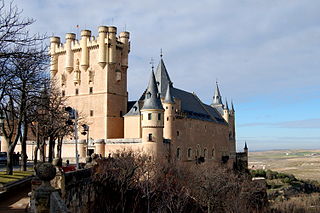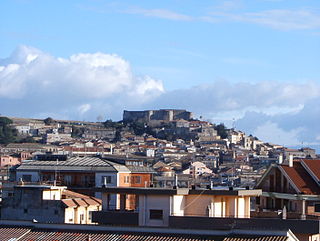
Captain America is a fictional superhero appearing in American comic books published by Marvel Comics. Created by cartoonists Joe Simon and Jack Kirby, the character first appeared in Captain America Comics #1 from Timely Comics, a predecessor of Marvel Comics. Captain America was designed as a patriotic supersoldier who often fought the Axis powers of World War II and was Timely Comics' most popular character during the wartime period. The popularity of superheroes waned following the war and the Captain America comic book was discontinued in 1950, with a short-lived revival in 1953. Since Marvel Comics revived the character in 1964, Captain America has remained in publication.
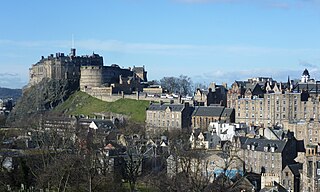
Edinburgh Castle is a historic fortress which dominates the skyline of the city of Edinburgh, Scotland, from its position on the Castle Rock. Archaeologists have established human occupation of the rock since at least the Iron Age, although the nature of the early settlement is unclear. There has been a royal castle on the rock since at least the reign of David I in the 12th century, and the site continued to be a royal residence until 1633. From the 15th century the castle's residential role declined, and by the 17th century it was principally used as military barracks with a large garrison. Its importance as a part of Scotland's national heritage was recognised increasingly from the early 19th century onwards, and various restoration programmes have been carried out over the past century and a half. As one of the most important strongholds in the Kingdom of Scotland, Edinburgh Castle was involved in many historical conflicts from the Wars of Scottish Independence in the 14th century to the Jacobite rising of 1745. Research undertaken in 2014 identified 26 sieges in its 1100-year-old history, giving it a claim to having been "the most besieged place in Great Britain and one of the most attacked in the world".

The Punisher is a fictional character appearing in American comic books published by Marvel Comics. The character was created by writer Gerry Conway and artists John Romita Sr. and Ross Andru, with publisher Stan Lee green-lighting the name. The Punisher made his first appearance in The Amazing Spider-Man #129.

Deal Castle is an artillery fort constructed by Henry VIII in Deal, Kent, between 1539 and 1540. It formed part of the King's Device programme to protect against invasion from France and the Holy Roman Empire and defended the strategically important Downs anchorage off the English coast. Comprising a keep with six inner and outer bastions, the moated stone castle covered 0.85 acres (0.34 ha) and had sixty-six firing positions for artillery. It cost the Crown a total of £27,092 to build the three castles of Deal, Sandown and Walmer, which lay adjacent to one another along the coast and were connected by earthwork defences. The original invasion threat passed but, during the Second English Civil War of 1648–49, Deal was seized by pro-Royalist insurgents and was only retaken by Parliamentary forces after several months' fighting.

Yarmouth Castle is an artillery fort built by Henry VIII in 1547 to protect Yarmouth Harbour on the Isle of Wight from the threat of French attack. Just under 100 feet (30 m) across, the square castle was initially equipped with 15 artillery guns and a garrison of 20 men. It featured an Italianate "arrow-head" bastion on its landward side; this was very different in style from the earlier circular bastions used in the Device Forts built by Henry and was the first of its kind to be constructed in England.
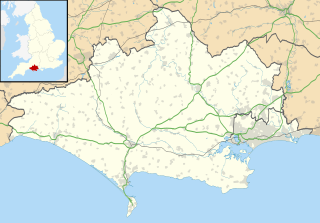
Portland Castle is an artillery fort constructed by Henry VIII on the Isle of Portland, Dorset, between 1539 and 1541. It formed part of the King's Device programme to protect against invasion from France and the Holy Roman Empire, and defended the Portland Roads anchorage. The fan-shaped castle was built from Portland stone, with a curved central tower and a gun battery, flanked by two angular wings. Shortly after its construction it was armed with eleven artillery pieces, intended for use against enemy shipping, operating in partnership with its sister castle of Sandsfoot on the other side of the anchorage. During the English Civil War, Portland was taken by the Royalist supporters of King Charles I, and then survived two sieges before finally surrendering to Parliament in 1646.

Pendennis Castle is an artillery fort constructed by Henry VIII near Falmouth, Cornwall, England between 1540 and 1542. It formed part of the King's Device programme to protect against invasion from France and the Holy Roman Empire, and defended the Carrick Roads waterway at the mouth of the River Fal. The original, circular keep and gun platform was expanded at the end of the century to cope with the increasing Spanish threat, with a ring of extensive stone ramparts and bastions built around the older castle. Pendennis saw service during the English Civil War, when it was held by the Royalists, and was only taken by Parliament after a long siege in 1646. It survived the interregnum and Charles II renovated the fortress after his restoration to the throne in 1660.

Captain Marvel (Mar-Vell) is a fictional superhero appearing in American comic books published by Marvel Comics. The character was created by writer-editor Stan Lee and designed by artist Gene Colan and first appeared in Marvel Super-Heroes #12.

Dunstaffnage Castle is a partially ruined castle in Argyll and Bute, western Scotland. It lies 3 miles (4.8 km) N.N.E. of Oban, situated on a platform of conglomerate rock on a promontory at the south-west of the entrance to Loch Etive, and is surrounded on three sides by the sea.
John Tropea is an American guitarist.

Red onions are cultivars of the onion with purplish-red skin and white flesh tinged with red.

HMHS Llandovery Castle, built in 1914 in Glasgow as RMS Llandovery Castle for the Union-Castle Line, was one of five Canadian hospital ships that served in the First World War. On a voyage from Halifax, Nova Scotia to Liverpool, England, the ship was torpedoed off southern Ireland on 27 June 1918. The sinking was the deadliest Canadian naval disaster of the war. Tragically, 234 doctors, nurses, members of the Canadian Army Medical Corps, soldiers and seamen died in the sinking and subsequent machine-gunning of lifeboats. Only 24 people, the occupants on a single life-raft, survived. The incident became infamous internationally as one of the war’s worst atrocities. After the war, the case of Llandovery Castle was one of six British cases presented at the Leipzig trials.

Sebastian Stan is a Romanian-American actor. On television, he has played Carter Baizen in Gossip Girl, Prince Jack Benjamin in Kings, Jefferson in Once Upon a Time, and T.J. Hammond in Political Animals. The latter earned him a nomination for the Critics' Choice Television Award for Best Supporting Actor in a Movie/Miniseries.
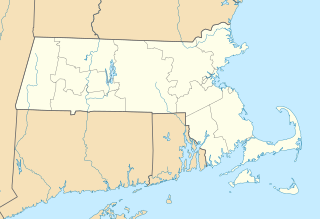
Fort Independence is a granite bastion fort that provided harbor defenses for Boston, Massachusetts. Located on Castle Island, Fort Independence is one of the oldest continuously fortified sites of English origin in the United States. The first primitive fortification, called "The Castle", was placed on the site in 1634 and, after two re-buildings, replaced circa 1692 with a more substantial structure known as Castle William. Re-built after it was abandoned by the British during the American Revolution, Castle William was renamed Fort Adams and then Fort Independence. The existing granite fort was constructed between 1833 and 1851. Today it is preserved as a state park and fires occasional ceremonial salutes. Fort Independence was added to the National Register of Historic Places in 1970.
Sleeper is the name of several fictional characters appearing in American comic books published by Marvel Comics. The Sleepers are depicted as a series of five destructive robots created by the Red Skull.
In 1781, Great Britain declared war on the Dutch Republic, opening the Fourth Anglo-Dutch War. As part of its offensive strategy, the British organized an expedition against Dutch colonial outposts on the Gold Coast of Africa. Captain Thomas Shirley led the expedition, commanding HMS Leander and several transports carrying two small regiments of independently raised troops under the command of Captain Kenneth Mackenzie of the 78th Foot.
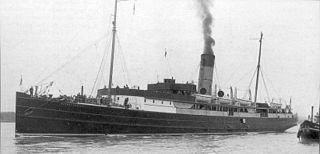
The packet steamer SS Rushen Castle was operated by the Isle of Man Steam Packet Company from her purchase in 1928 until she was sold for breaking in 1947.
Castle Conway is a former castle and stately home that was situated in the town of Killorglin, County Kerry, Ireland. Today only the ruins of one wall remain.
Fernando Tropea was a prolific Italian film editor, who worked on around ninety films during his twenty-year career. During the Fascist era he worked on films such as Naples of Former Days (1938) and Carmen fra i rossi (1939).

